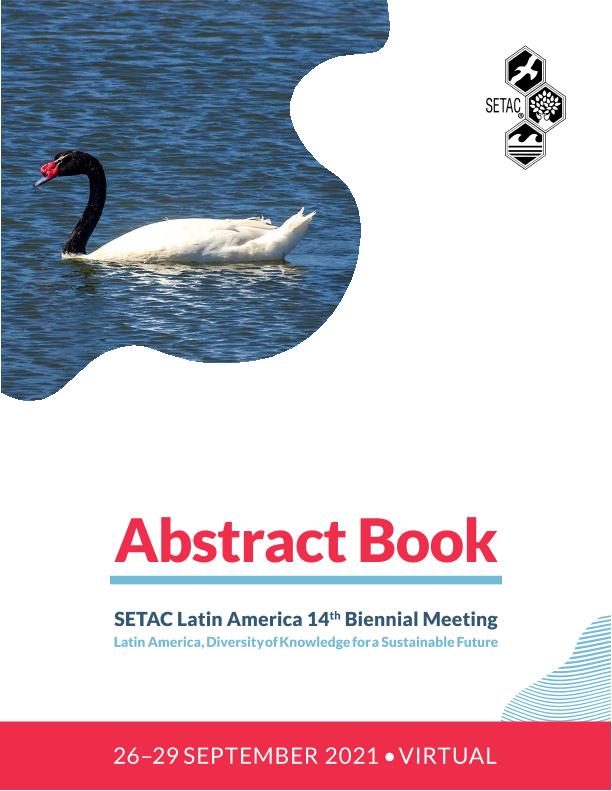Mostrar el registro sencillo del ítem
dc.contributor.author
Murphy, K.
dc.contributor.author
Oser, Federico Leandro

dc.contributor.author
Salgado Costa, Carolina

dc.contributor.author
Cellone, Francisco Aldo

dc.contributor.author
Peluso, María Leticia

dc.contributor.author
Carol, Eleonora Silvina

dc.contributor.author
Natale, Guillermo Sebastian

dc.date.available
2022-10-12T14:43:15Z
dc.date.issued
2021
dc.identifier.citation
Evaluation of the toxicity of sediments from a feedlot influenced area located in Northeastern Buenos Aires (Argentina) by bioassays with Hyalella curvispina; Latin America 14th Biennial Meeting; Estados Unidos; 2021; 48-49
dc.identifier.uri
http://hdl.handle.net/11336/172677
dc.description.abstract
Intensive animal production of the feedlot type has spread in the Pampas region of Argentina. These activities can act as point sources of contamination if they are not properly designed and managed. The generation of large amounts of manure and its decomposition, releases, among other elements, nutrients that can infiltrate, or be transported by runoff and reach water courses where they can be captured by bottom sediments. A useful bioanalytical tool for diagnosing ecosystems is sediment toxicity bioassays. The aim of the study was to evaluate the toxicity of sediment samples from water courses in an area with present feedlot activity using Hyallela curvispina, a representative species of aquatic ecosystems of the neotropics. The study area is in a sub-basin of the El Pescado stream, northeast of the province of Buenos Aires, where a feedlot has been active since 2014. Four sediment samples were collected: 1) directly from a waterway that rounds the feeding lot, 2) from a waterbody located at the perimeter of the establishment, 3) from a permanent course of the sub-basin under study located 1 km downhill, and 4) from a reference site located 30 km from the feedlot. A bioassay (10 days) was performed following standardized protocols of the American Society for Testing Materials with minor modifications, placing 100 mL of sediment samples and 175 mL of water in 500 mL glass containers. Eight replicates per sample were used with 10 juveniles of H. curvispina. Mortality was determined by direct observation, and growth inhibition was assessed by measuring body length after digital photograph with the ImageJ program. In addition, physicochemical measurements (hardness, alkalinity, nutrients, among others) were made, and surface runoff and land use classification through the joint analysis of digital elevation models were evaluated using geographic information system tools. Sediments from the feedlot and the perimetral area showed significantly higher toxicity (p < 0.05) than the other ones, which showed less than 10% mortality. The results obtained allow us to conclude that the feedlot establishment is a locally pollution source, and toxicity bioassays are an efficient tool for the evaluation of environmental pollution. Future studies will focus on taking more samples from those sites where modeling and analysis of physicochemical parameters indicate whether pollutants are reaching the sites through runoff, and determining the pollution plume.
dc.format
application/pdf
dc.language.iso
eng
dc.publisher
Society of Environmental Toxicology and Chemistry

dc.rights
info:eu-repo/semantics/openAccess
dc.rights.uri
https://creativecommons.org/licenses/by-nc-sa/2.5/ar/
dc.subject
INTENSIVE ANIMAL PRODUCTION
dc.subject
SURFACE WATER
dc.subject
CONTAMINATION
dc.subject.classification
Oceanografía, Hidrología, Recursos Hídricos

dc.subject.classification
Ciencias de la Tierra y relacionadas con el Medio Ambiente

dc.subject.classification
CIENCIAS NATURALES Y EXACTAS

dc.title
Evaluation of the toxicity of sediments from a feedlot influenced area located in Northeastern Buenos Aires (Argentina) by bioassays with Hyalella curvispina
dc.type
info:eu-repo/semantics/publishedVersion
dc.type
info:eu-repo/semantics/conferenceObject
dc.type
info:ar-repo/semantics/documento de conferencia
dc.date.updated
2022-06-13T14:29:51Z
dc.journal.pagination
48-49
dc.journal.pais
Estados Unidos

dc.description.fil
Fil: Murphy, K.. Universidad de Dublin; Irlanda
dc.description.fil
Fil: Oser, Federico Leandro. Universidad Nacional de La Plata. Facultad de Ciencias Exactas. Departamento de Química. Centro de Investigaciones del Medio Ambiente; Argentina. Consejo Nacional de Investigaciones Científicas y Técnicas. Centro Científico Tecnológico Conicet - La Plata; Argentina
dc.description.fil
Fil: Salgado Costa, Carolina. Universidad Nacional de La Plata. Facultad de Ciencias Exactas. Departamento de Química. Centro de Investigaciones del Medio Ambiente; Argentina. Consejo Nacional de Investigaciones Científicas y Técnicas. Centro Científico Tecnológico Conicet - La Plata; Argentina
dc.description.fil
Fil: Cellone, Francisco Aldo. Consejo Nacional de Investigaciones Científicas y Técnicas. Centro Científico Tecnológico Conicet - La Plata; Argentina. Universidad Nacional de La Plata. Facultad de Ciencias Exactas. Departamento de Química. Centro de Investigaciones del Medio Ambiente; Argentina. Consejo Nacional de Investigaciones Científicas y Técnicas. Centro Científico Tecnológico Conicet - La Plata. Centro de Investigaciones Geológicas. Universidad Nacional de La Plata. Facultad de Ciencias Naturales y Museo. Centro de Investigaciones Geológicas; Argentina
dc.description.fil
Fil: Peluso, María Leticia. Consejo Nacional de Investigaciones Científicas y Técnicas. Centro Científico Tecnológico Conicet - La Plata; Argentina. Universidad Nacional de La Plata. Facultad de Ciencias Exactas. Departamento de Química. Centro de Investigaciones del Medio Ambiente; Argentina
dc.description.fil
Fil: Carol, Eleonora Silvina. Consejo Nacional de Investigaciones Científicas y Técnicas. Centro Científico Tecnológico Conicet - La Plata. Centro de Investigaciones Geológicas. Universidad Nacional de La Plata. Facultad de Ciencias Naturales y Museo. Centro de Investigaciones Geológicas; Argentina
dc.description.fil
Fil: Natale, Guillermo Sebastian. Consejo Nacional de Investigaciones Científicas y Técnicas. Centro Científico Tecnológico Conicet - La Plata; Argentina. Universidad Nacional de La Plata. Facultad de Ciencias Exactas. Departamento de Química. Centro de Investigaciones del Medio Ambiente; Argentina
dc.relation.alternativeid
info:eu-repo/semantics/altIdentifier/url/https://cdn.ymaws.com/www.setac.org/resource/resmgr/abstract_books/SLA-14-abstract-book.pdf
dc.relation.alternativeid
info:eu-repo/semantics/altIdentifier/url/https://www.setac.org/store/viewproduct.aspx?id=19048710#:~:text=This%20book%20comprises%20the%20abstracts,and%20appear%20in%20numerical%20order.
dc.conicet.rol
Autor

dc.conicet.rol
Autor

dc.conicet.rol
Autor

dc.conicet.rol
Autor

dc.conicet.rol
Autor

dc.conicet.rol
Autor

dc.conicet.rol
Autor

dc.coverage
Internacional
dc.type.subtype
Reunión
dc.description.nombreEvento
Latin America 14th Biennial Meeting
dc.date.evento
2021-08-26
dc.description.paisEvento
Estados Unidos

dc.type.publicacion
Book
dc.description.institucionOrganizadora
Society of Environmental Toxicology and Chemistry
dc.source.libro
Abstract Book: Latin America 14th Biennial Meeting
dc.date.eventoHasta
2021-08-29
dc.type
Reunión
Archivos asociados
